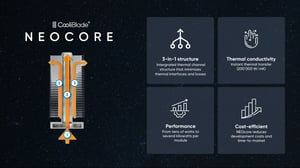This is the second part of our blog series on NEOcore technology. We'll show you how integrated thermosyphon design achieves 1,000× better thermal conductivity than aluminum, with measured results from real power electronics projects.
The Thermal Bottleneck
Power density in electronics continues to increase. IGBT and SiC modules now dissipate hundreds of watts to 3 kW per module in increasingly compact form factors. Traditional aluminum heat sinks can't keep up. Heat pipes add thermal interfaces and manufacturing complexity. Liquid cooling adds cost, maintenance, and failure modes.
The industry needs air-cooling that performs like liquid cooling, without the complexity.
How NEOcore Works
NEOcore integrates a sealed thermosyphon channel directly into an aluminum heat sink structure. The result is effective thermal conductivity of approximately 200,000 W/mK—over 1,000× higher than aluminum (205 W/mK) and 10× higher than typical heat pipes (~18,000 W/mK).
This isn't an incremental improvement. It's a fundamental change in what's possible with air cooling.
The Architecture:

- Large Surface Evaporator – The entire base surface contacts the power module, maximizing heat absorption area and minimizing thermal resistance at the critical interface.
- Direct Thermal Channel – Heat transfers rapidly through the integrated NEOcore channel with minimal resistance. No additional thermal interfaces between evaporator and condenser.
- Efficient Condenser – Vapor condenses in the fin area where large surface area interfaces with airflow, efficiently rejecting heat to ambient air.
- Optimized Air Interface – Large fin surface area near the condensation zone ensures efficient heat dissipation without requiring high-velocity forced air.
Measured Performance
| Metric | Result |
|---|---|
| Thermal Conductivity | 200,000 W/mK (1,000× vs. aluminum) |
| Temperature Reduction | ~25°C in customer applications |
| Weight Reduction | 50% vs. conventional solutions |
| Power Handling | Up to 3 kW per module |
These numbers come from actual power converter deployments, not lab conditions.
Design Advantages
Integrating thermosyphon technology directly into the heat sink structure creates several key engineering benefits. Eliminating the thermal interface between heat pipe and sink reduces overall thermal resistance and simplifies assembly. The design operates passively—no pumps, no moving parts, no maintenance—with gravity-driven phase change managing heat transfer automatically. Higher thermal performance enables smaller heat sinks for the same power dissipation, or higher power handling in the same space. The hollow aluminum structure with integrated cooling weighs 50% less than solid aluminum heat sinks delivering equivalent performance. Finally, modular architecture adapts to different power levels and form factors without requiring a complete redesign.
Where NEOcore Makes Impact
NEOcore handles power densities from hundreds of watts to 3 kW per module across demanding applications. Renewable energy systems use it in solar string inverters, central inverters, and hybrid PV-storage systems where reliability and maintenance-free operation are critical. EV charging infrastructure benefits from lower temperatures that enable higher continuous charging power and better station uptime. Energy storage systems rely on NEOcore for consistent thermal management across repeated charge-discharge cycles. Industrial frequency converters and motor drives use it where compact packaging meets high-power requirements. Telecommunications equipment, particularly 5G base stations in outdoor enclosures, and specialized applications like medical devices, military electronics, and high-power lasers all benefit from passive cooling that doesn't fail.
Cost-Effective Manufacturing
Superior performance matters only if production costs are competitive. NEOcore is designed for automated European manufacturing with scalable production from prototypes to 100,000+ units annually.
Single-material aluminum construction simplifies supply chain. Integrated design reduces assembly steps. Passive operation eliminates pumps and controls. Lower weight reduces shipping costs. Longer component life reduces warranty costs.
The Engineering Advantage
NEOcore delivers liquid-cooling performance with air-cooling simplicity. No plumbing. No leak risk. No pump failures. Just passive, reliable thermal management that lets power electronics operate cooler, more efficiently, and longer.
For engineers designing power converters, inverters, and charging systems, NEOcore removes thermal constraints that traditionally force compromises between power density, reliability, and cost.
Next in this series: detailed case studies showing measured temperature reductions and weight savings in MW-scale power converters.
Need thermal simulation for your power electronics project? Contact our engineering team.
Contact our cooling experts | Learn more about NEOcore technology
